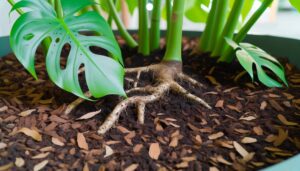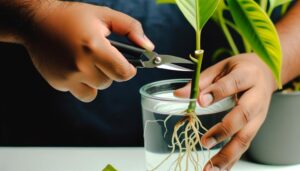Monstera Pinnatipartita Variegated
Monstera Pinnatipartita Variegated, a member of the Araceae family, hails from Central and South American rainforests. Its pinnatifid leaf structure and variegation, due to genetic mutations, make it highly prized.
For best growth, provide bright, indirect light, 18-27°C temperatures, and high humidity. Use well-draining, organic-rich soil and water when the top soil layer is dry.
Fertilize biweekly with a balanced solution. Prevent root rot by maintaining proper drainage and avoid pest infestations.
Propagate using stem cuttings with nodes and aerial roots. Discover more about its unique care and propagation methods that optimize its vibrant health.
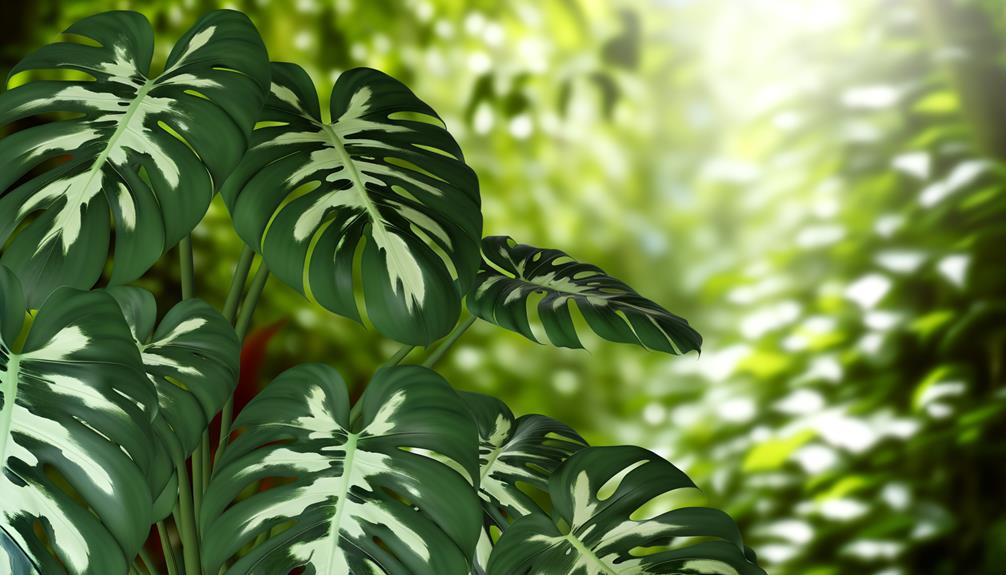
Key Takeaways
- Monstera Pinnatipartita Variegated originates from Central and South American rainforests.
- Requires bright, indirect light and high humidity for optimal growth.
- Soil should be well-draining and rich in organic matter.
- Water when the top 1-2 inches of soil are dry to prevent root rot.
- Propagate using stem cuttings with nodes and aerial roots.
Origin and History

The Monstera pinnatipartita variegated, a stunningly unique cultivar, originates from the tropical rainforests of Central and South America. You'll find it thriving in the humid, shaded environments of countries like Colombia, Ecuador, and Peru.
This species belongs to the Araceae family, which includes other well-known plants like the Philodendron and Anthurium. Monstera pinnatipartita was first described by plant taxonomists due to its distinct pinnate leaf structure.
Variegation in this cultivar results from genetic mutations, creating unique color patterns that collectors cherish. Throughout history, indigenous peoples have utilized various Monstera species for medicinal and ornamental purposes.
Today, it's highly sought after by horticulturists and plant enthusiasts worldwide for its aesthetic and botanical value.
Unique Features
In addition to its rich history, Monstera pinnatipartita variegated boasts a myriad of unique features that set it apart from other members of the Araceae family. You'll find that its striking variegation isn't just visually enthralling but also botanically intriguing.
Key features include:
- Leaf Morphology: The leaves exhibit pinnatifid divisions, creating a deeply lobed appearance that enhances its aesthetic appeal.
- Variegation Patterns: Each leaf showcases a blend of green and creamy white variegation, resulting from a genetic mutation affecting chlorophyll distribution.
- Aerial Roots: The plant produces prominent aerial roots, aiding in nutrient absorption and providing structural support.
These features contribute to its unique status and make it a prized specimen for collectors and botanists alike.
Ideal Growing Conditions
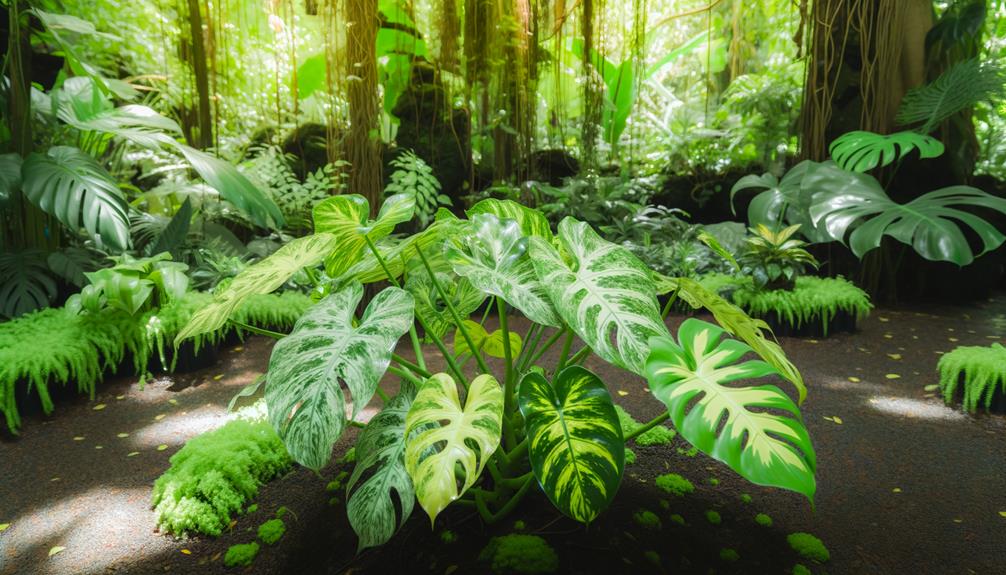
To maximize growth for Monstera pinnatipartita variegated, you need to focus on specific environmental parameters.
Provide bright, indirect light and maintain a temperature range of 18-27°C.
Additionally, use well-draining soil and optimize humidity levels stay between 60-80%.
Light and Temperature Needs
Although Monstera pinnatipartita variegated thrives in bright, indirect sunlight, it can tolerate lower light conditions but will exhibit slower growth. To optimize its vigor, exposure to ideal light and temperature conditions is vital.
Here's what you need:
- Light: Place the plant in a spot with filtered sunlight, avoiding direct rays which can scorch the variegated leaves.
- Temperature: Maintain an ambient temperature between 65°F and 80°F (18°C to 27°C). This range mimics the tropical environment it's native to.
- Consistency: Avoid sudden temperature fluctuations and cold drafts, as these can stress the plant.
Soil and Humidity Preferences
For optimal growth, Monstera pinnatipartita variegated needs a well-draining soil mix rich in organic material and high humidity levels that mimic its native tropical environment.
You should use a substrate made of peat, perlite, and orchid bark to guarantee sufficient aeration and moisture retention. Maintaining a humidity level of 60% or higher is essential, as this plant thrives in damp surroundings.
You can achieve this by using a humidifier or placing the plant on a humidity tray. Regular misting can also help, but avoid saturating the soil. Ensuring proper soil pH, around 5.5 to 7.0, will optimize nutrient absorption.
Soil Requirements
For best growth, your Monstera pinnatipartita variegated requires a soil composition rich in organic matter, ensuring both nutrient availability and moisture retention.
Proper drainage and aeration are essential to prevent root rot and promote healthy root development. Consider using a mix of peat, perlite, and orchid bark to achieve the ideal balance.
Ideal Soil Composition
An ideal soil composition for Monstera pinnatipartita variegated includes a well-draining mix of peat, perlite, and orchid bark. This specific blend guarantees optimal root health and nutrient uptake.
To create the perfect soil mix, you'll need:
- Peat: Provides moisture retention and organic matter, essential for root development.
- Perlite: Improves aeration and drainage, preventing root rot and compaction.
- Orchid Bark: Adds structure and increases porosity, resembling the plant's natural epiphytic environment.
Each component serves a specific function, promoting a balanced environment for your Monstera pinnatipartita variegated.
Make sure that the soil remains slightly acidic to neutral (pH 5.5-7). This combination not only supports robust growth but also reduces the risk of common soil-borne issues.
Drainage and Aeration
Promoting proper drainage and aeration is crucial for the healthiest growth of Monstera pinnatipartita variegated, as it replicates the plant's natural environment and prevents root-related issues.
You should use a well-draining substrate, such as a blend of orchid bark, perlite, and sphagnum peat moss. This combination facilitates ideal water retention and root oxygenation. Avoid dense soils, which can result in waterlogging and root rot. Integrate coarse materials like pumice or horticultural charcoal to enhance soil structure.
Regularly inspect drainage holes to ensure they're clear. Sufficient airflow around the roots is vital; consider using a pot with ventilation holes.
Watering Needs
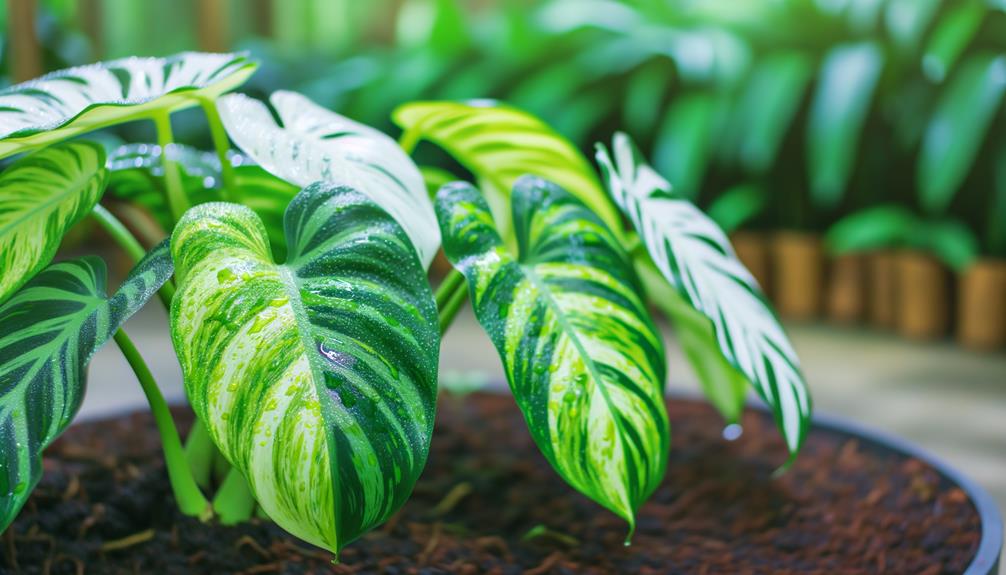
Proper watering is essential for maintaining the health of Monstera Pinnatipartita Variegated, ensuring the soil remains consistently moist but never waterlogged. Here's how you can achieve the best hydration:
- Frequency: Water the plant when the top 1-2 inches (2.5-5 cm) of soil feels dry to the touch. Overwatering can lead to root rot.
- Method: Use a watering can with a narrow spout to evenly distribute water around the base. Avoid wetting the foliage to prevent fungal issues.
- Water Quality: Utilize filtered or rainwater, as tap water often contains chlorine and fluoride, which can harm the plant's delicate roots.
Light Preferences
You should provide Monstera Pinnatipartita Variegated with bright, indirect light to optimize its photosynthetic efficiency. Direct sunlight can cause foliar damage, leading to chlorosis and necrosis.
For indoor cultivation, consider placing it near an east-facing window or using grow lights to simulate ideal light conditions.
Ideal Light Conditions
Monstera Pinnatipartita Variegated thrives in bright, indirect light, which mimics its natural habitat under the forest canopy. Ensuring ideal lighting conditions is essential for the photosynthetic efficiency and overall health of this species.
You should focus on:
- Light Intensity: Bright, filtered light is best, avoiding extremes that could stress the plant.
- Duration: Aim for 10-12 hours of consistent light exposure daily to support robust growth.
- Source: East or west-facing windows provide suitable light, as does the use of grow lights tailored for tropical species.
Maintaining these conditions helps the Monstera Pinnatipartita Variegated to sustain its variegation and intricate leaf morphology. Correct lighting enhances chlorophyll production, ensuring your plant remains vibrant and healthy.
Avoiding Direct Sunlight
Direct sunlight can lead to leaf scorching and reduced variegation in Monstera Pinnatipartita Variegated, necessitating its placement in areas with diffused light.
You should position this plant in spaces where light is filtered through sheer curtains or ambient sources. Direct exposure to intense solar radiation can damage the chlorophyll, leading to unsightly brown patches and diminished aesthetic appeal.
As a variegated species, Monstera Pinnatipartita thrives in a balance of light that allows for photosynthesis without overwhelming delicate leaf tissue. It's essential to avoid placing it near windows with harsh, unfiltered sunlight. Instead, aim for bright, indirect light to maintain its vibrant variegation and overall health.
Proper light management ensures peak growth and longevity for your Monstera Pinnatipartita Variegated.
Indoor Light Options
Considering the need for diffused light, various indoor light options can cater to the light preferences of Monstera Pinnatipartita Variegated, ensuring ideal growth and vibrant variegation. This species thrives under conditions that mimic its natural understory habitat.
Here are three best-suited light options:
- LED Grow Lights: These provide a full spectrum light that closely replicates natural sunlight, promoting balanced photosynthesis.
- Fluorescent Lights: Ideal for maintaining the variegation, these lights emit less heat and can be placed closer to the plant without causing damage.
- Indirect Natural Light: Positioning the plant near a north or east-facing window allows for ample ambient light without the risk of scorching the leaves.
These options will help you maintain the health and aesthetic of your Monstera Pinnatipartita Variegated.
Fertilization Tips
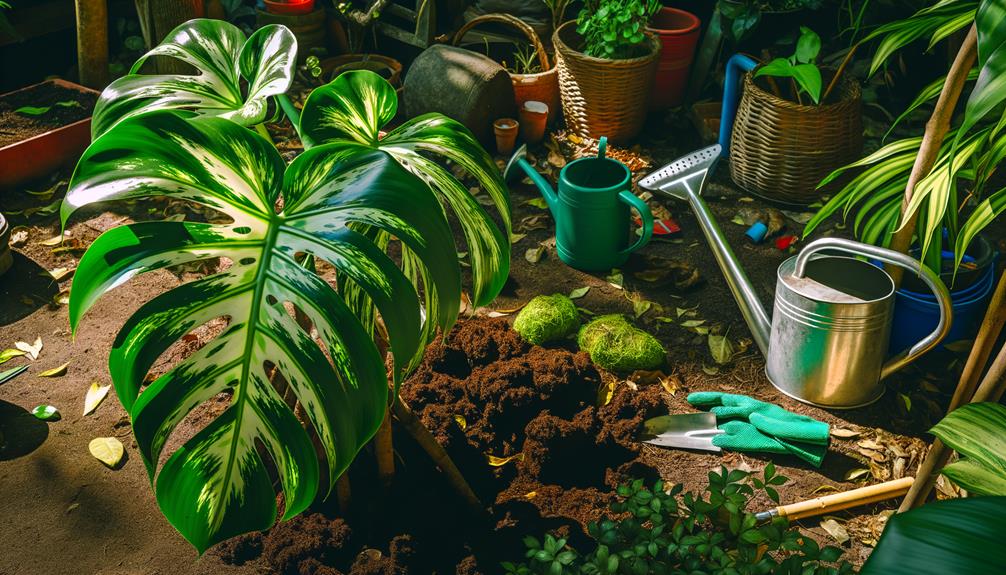
When fertilizing Monstera pinnatipartita variegated, aim to use a balanced, water-soluble fertilizer with a nutrient ratio of 20-20-20, diluted to half strength. Apply it biweekly during the growing season to maintain optimal nutrient absorption. Maintain even distribution around the root zone to avoid nutrient burn.
| Fertilizer Type | Application Frequency |
|---|---|
| 20-20-20 Balanced | Biweekly during growth |
| Organic Liquid | Monthly |
| Slow-Release | Every 2-3 months |
It's essential to monitor for signs of over-fertilization, such as yellowing leaves or burnt roots. Adjust the frequency based on observed plant response. During dormancy, reduce fertilization to prevent excessive nutrient buildup. Regular soil testing can provide insights into specific nutrient needs, ensuring your Monstera pinnatipartita variegated thrives.
Pruning and Maintenance
Pruning Monstera pinnatipartita variegated promotes healthy growth and encourages a bushier, more aesthetically pleasing plant structure. Selective pruning helps manage the plant's rapid growth and prevents leggy stems.
Follow these steps for effective pruning:
- Identify Nodes: Cut just above a node to stimulate new growth.
- Sanitize Tools: Use sterilized pruning shears to prevent pathogen transmission.
- Remove Damaged Leaves: Eliminate yellowing or diseased foliage to maintain plant health.
Pruning not only shapes the plant but also enhances variegation by encouraging new variegated leaves. Regular maintenance, including removing dead or decaying plant matter, is essential.
Common Pests and Diseases
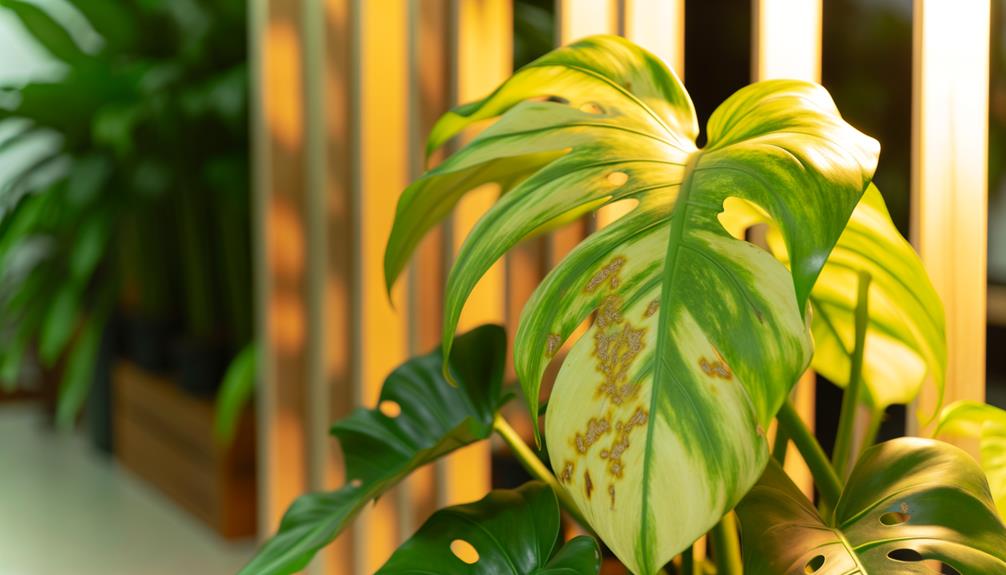
Monstera pinnatipartita variegated is vulnerable to pests like spider mites, aphids, and scale insects, along with diseases such as root rot and powdery mildew. Spider mites (Tetranychus urticae) cause stippling on leaves, while aphids (Aphidoidea) secrete honeydew that attracts mold. Scale insects (Coccoidea) form protective covers, draining plant sap. Root rot often occurs due to overwatering, leading to decayed roots. Powdery mildew, distinguished by white fungal growth, thrives in high humidity.
| Pests | Diseases |
|---|---|
| Spider Mites | Root Rot |
| Aphids | Powdery Mildew |
| Scale Insects |
Regularly examine your plant for signs of infestation or disease. Early detection and treatment are essential for maintaining its health. Use insecticidal soap or neem oil for pest control and maintain proper watering practices to prevent diseases.
Propagation Methods
Propagation of Monstera pinnatipartita variegated is typically achieved through stem cuttings, guaranteeing the preservation of its unique variegation. You'll need to carefully select a healthy stem with at least one node and a few aerial roots.
Here's a concise guide:
- Cutting Preparation: Use sterilized pruning shears to make a clean cut below a node. Make sure the cutting has multiple leaves and visible variegation.
- Rooting: Place the cutting in water or a well-draining soil mix. Maintain high humidity and consistent moisture to promote root development.
- Transplanting: Once roots are established, transfer the cutting to a pot with nutrient-rich, well-draining soil. Provide indirect light to support growth.
Conclusion
In cultivating Monstera pinnatipartita variegated, you're nurturing a botanical marvel. Embrace its needs—well-draining soil, consistent watering, and balanced fertilization—to see it flourish.
Prune with precision to maintain its elegant form and guard against pests. Propagation, though meticulous, rewards you with new life.
As you care for this plant, imagine it as a living tapestry, each variegated leaf a stroke of nature's artistry, enhancing your collection with unparalleled beauty.


